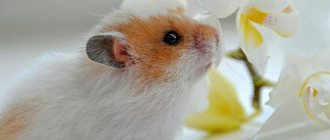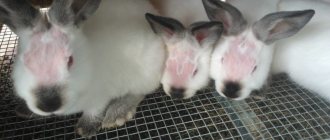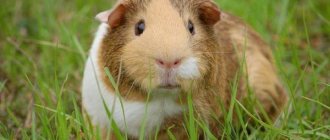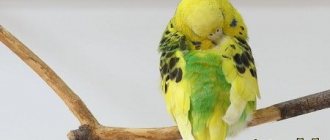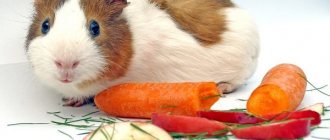A novice herdsman does not always understand why the pig does not eat, but lies. This situation cannot be ignored, because the appetite of livestock is one of the main indicators of its health. There are several reasons that cause this problem: from improper living conditions for animals and poor diet, to serious infectious diseases. Let's figure out what to do if the pig doesn't get up and refuses to eat.
Reasons for refusing to eat
A completely healthy pig has a good appetite. If the animal has become less active, constantly lies down and does not touch food, you need to look for a problem. Livestock may ignore feed completely or eat very little. Such a reaction most often indicates some kind of pathology in the pig’s body. The reason may be due to the following factors:
- avitaminosis;
- worms;
- infections;
- all kinds of diseases;
- improper care;
- stress.
Vitamin deficiency in pigs is most often caused by a lack of vitamin D, which appears due to an unbalanced diet and lack of essential microelements. Worms enter the body through water, unprocessed meat and soil. They cause bacterial and viral infections that cause intoxication. Also, the reasons for refusing food are stressful situations, poor quality care and maintenance, and loud noise from operating appliances. Below we will take a closer look at each of the reasons.
If a nursing pig refuses to eat, health problems may arise for her offspring.
Why does the piglet eat poorly?
A good appetite in animals is the main sign of their health. If a pig does not eat, this indicates some kind of disorder in the body. It is important for farmers to pay attention in time to whether their pets are willing to eat it. Early diagnosis will help to begin timely treatment of a sick individual, which means the business will flourish. This article will reveal the main causes of loss of appetite in pigs and suggest ways to solve the problem.
Poor appetite in piglets
Exanthema vesicular
The piglet refuses food due to exanthema, an infectious pathology. The cause is calicivirus. The incubation period for the disease lasts from 12 hours to 2 weeks. During exanthema, the animal has a fever, and its body is covered with many rashes. Also, neoplasms appear on the mucous membranes of the mouth and snout. Inside the rash there is serous fluid.
The pig feels very weak, so he constantly lies down. After some time, the temperature of sick cattle drops, and the affected areas become covered with a yellow crust. Without proper treatment, the second stage of the disease begins, during which the rash covers the toes and hooves. The animal still does not eat and begins to limp. A sow gives birth to a dead piglet. The uncomplicated form of the disease lasts about 1-1.5 weeks, while the chronic form lasts 2-3 weeks.
Why piglets eat poorly: reasons and how to fix it
Every pig farmer will start to worry when he discovers that the pig is not eating. After all, refusal to eat often indicates the appearance of an infection or the development of inflammation in the animal’s body. If food remains in the feeder after two hours, then you should pay attention to this alarming symptom even in the absence of other external signals of infection.
Piglets' refusal to eat often indicates that they have some kind of pathology.
Causes
There can be many reasons why an animal refuses to eat.
- Worms. First of all, it is important to exclude the possibility of helminth infection, since their appearance often causes loss of appetite. It is necessary to carry out mandatory measures and, if no traces of parasites are found, exclude them from possible reasons for refusing food.
- Wrong diet. It may be another reason for a decrease in appetite in a piglet. Some farmers give their animals only grain or dry food, which is not allowed. With this feeding, the pig does not receive the necessary proteins and other nutrients, which leads to a prolonged decrease in appetite.
- Vitamin D deficiency is also one of the reasons why piglets may stop eating. It is produced in the body due to exposure to sunlight. If the piglet moves little, preferring to lie down, and spends a lot of time in the pigsty, then a lack of vitamin D can be suspected.
The cause of lack of appetite may be an unbalanced diet or the presence of parasites. If the pig is reluctant to eat, then it is necessary to give it fish oil. Animals like the smell of this drug, and after taking it their appetite increases.
- Air temperature. A piglet may refuse food due to unfair management. Unlike adult pigs, young animals tolerate the cold very hard. If the temperature in the pigsty is low, then all the resources of the animal’s body will be spent on heating. The only thing that needs to be done to eliminate this reason is to insulate the pigsty or move the young animals to a warmer place.
- Infectious diseases. A more dangerous reason for an animal to stop eating may be an infection. If the pig has lost its appetite, but there are no other external manifestations of the disease, then this may indicate an incubation period. This means that other symptoms of infection will soon appear. If disturbances in the functioning of the pet’s body become obvious, then drug treatment according to the indications of a specialist should not be postponed.
Refusal to eat does not always indicate the development of the disease. Appetite can be affected by factors such as: air temperature, unfair maintenance, excessive dampness.
Symptoms
Almost every pig disease is associated with loss of appetite, and diagnosing a specific one becomes not so easy. In addition to this symptom, there are several other signs indicating the presence of infection in the body:
- apathy or overexcitement;
- dry skin;
- matte bristles;
- the appearance of spots, rashes;
- temperature is below or above normal.
Dry skin, the appearance of spots and abnormal behavior of animals require mandatory attention from a veterinarian.
Major diseases
Diseases of pigs are provoked by poor housing, violation of temperature conditions or feeding with low-quality feed. Bacteria enter the body through contaminated food and water or through wounds. Piglets are more susceptible to illnesses than adult animals. Disease may be the reason why piglets do not eat well.
- Gastroenteritis and dyspepsia. They develop when sucklings are hastily transferred to an adult diet or against the background of a deficiency of vitamins A and B. These diseases are characterized by: weakness, refusal to eat, vomiting, diarrhea, pallor of the mucous membranes and a decrease in temperature.
- Bronchopneumonia and bronchitis. They begin due to keeping animals in damp, drafty rooms or against the background of sudden temperature changes. Main symptoms: fever, cough, mucous discharge from the nose, loss of appetite.
- Anemia. The basis is a sharp decrease in hemoglobin in the body of a growing animal. Main symptoms: pale skin, dull stubble, white diarrhea, refusal to eat, weight loss. Untimely measures taken can lead to the death of young animals.
- Plague. A disease transmitted through infected animals, pork carcasses, slaughter products, premises, food, clothing, equipment, etc. The plague is carried by rats and flies. The first symptoms: refusal to eat, fever, weakness, lethargy, inflammation of the eyes, red spots and rashes on the skin.
- Paratyphoid. Piglets are sick for 2 - 6 months. It occurs against the background of unscrupulous maintenance and feeding of sows. Symptoms of the acute form: fever, loss of appetite, lethargy, alternating diarrhea and constipation.
- Foot and mouth disease. A dangerous disease that is fatal to piglets. The main symptoms: fever, refusal to eat, the appearance of blisters and the formation of ulcers on the mucous membranes of the mouth, skin and udder.
Plague, paratyphoid and other dangerous diseases of pigs also cause lack of appetite. If your pet refuses to eat, becomes lethargic and lies around a lot, then you should seek help from a specialist, even if the cause of this condition is obvious. The health of the pig should not be neglected, as this may also affect the efficiency of pig farming.
Video Attention, TODAY only! Subscribe Stay up to date with new products on our site
Deadly Plague
If the pig does not eat because of the plague, immediate action must be taken. This is a highly contagious disease that affects the blood vessels.
Also, with severe plague, the gastrointestinal tract becomes inflamed and pulmonary pneumonia begins. The disease occurs in a feverish form. It is caused by a togavirus, which contains ribonucleic acid. It accumulates in the lymph, bone marrow, and affects blood vessels and the liver. The result is very deplorable: the walls of the blood vessels become thinner, hemorrhages begin, and the tissues die.
The incubation period of the plague extends to a maximum of a week. After this, the boar’s temperature rises sharply by 2 degrees, and hemorrhages appear near the ears, thighs and abdomen. Animals feel sick and vomit, they become lethargic and refuse to eat. They develop diarrhea and their stool contains blood clots.
At the moment there is no cure for plague, so the animal dies 2-3 days after the onset of the disease. In young livestock, the disease is more severe. Once the disease is confirmed, the animal is immediately slaughtered to prevent the spread of the pathology.
Enzootic pneumonia
Also, pigs do not eat because of pneumonia, during which the respiratory system suffers. The disease occurs due to a virus and most often affects young cattle under one month of age. The situation is complicated by the microbe's resistance to antibiotics, so it stays in the animal's body for a long time.
The incubation period lasts about 1.5-2 weeks, and the first symptoms appear after 3 weeks. The animal's temperature rises to 41 degrees or higher, and a dry cough and sneezing begins. If the disease is not treated, it can last for several months. Animals do not immediately refuse food. At first they continue to eat normally, but during feeding they begin to have a coughing fit. Then breathing quickens, the pigs feel depressed and stop eating, so they lose weight and height. With timely, proper treatment with antibiotics, the disease lasts 1-2 months.
What measures can be taken
If animals are found to be feeling unwell, refuse to feed, and are often in a lying position, it is necessary to find out the reason for this behavior.
If the problem lies in incorrect content, then you need to carefully look at what is going wrong and correct it. If you do not have the appropriate knowledge, you can find specialized literature or use the Internet.
Identifying diseases will require calling a veterinary specialist who can correctly diagnose and prescribe treatment. After following all the recommendations, livestock health problems become a thing of the past. To prevent certain infections, it is necessary to follow the vaccination calendar, give anthelmintics on time, and carry out disinfection measures in the pigsty. It is worth knowing that some diseases are still incurable, and therefore pigs with the proper symptoms must be destroyed to prevent the onset of epidemics.
Improper diet should be reviewed. The owner is recommended to familiarize himself with the existing feeding standards for various groups of animals, which have been developed by specialists, and provide food in accordance with the given requirements. Then there should be no problems with food refusal in pigs. Of course, low-quality feed should not be supplied to animals. Before distribution, it is recommended to check root crops for the presence of rot, and also clean them of the earthen layer.
Dangerous swine flu
Cattle may ignore feed due to influenza. This is an infection that has an acute course. It occurs due to the influenza virus, which causes inflammation of the mucous membranes of the respiratory system. The infection can be diagnosed by testing blood, urine, or cough secretions. The incubation period for influenza is short. The first symptoms begin 2 days after infection.
Animals' temperature rises sharply, 2 degrees above normal. They lie almost all the time, do not react to extraneous noises and refuse to eat. The respiratory system suffers, resulting in coughing and sneezing. If there is no treatment, conjunctivitis begins. During the flu, the piglet rubs its head against walls and doors, and the tail, limbs and ears take on a bluish tint.
Signs of the disease disappear after a few days, but then appear with renewed vigor. In addition to the above symptoms, arthritis, inflammation of the lungs and maxillary sinuses begin. In severe cases, meningitis may develop. In this case, there is a high mortality rate of piglets. On average, 50% of the total number of sick livestock die.
Viral gastroenteritis
This is another disease that causes pigs to refuse to eat. It is characterized by an acute course. The disease is caused by RNA containing coronavirus. Because of it, a large number of young animals die. The virus does not tolerate ultraviolet rays, light and heat, and therefore dies under their influence. Moreover, in severe frost conditions the virus is active for at least 2.5 years. The virus accumulates in the intestines, after which it enters the bloodstream and spreads throughout the internal organs.
The latent form of the disease in newborn piglets lasts up to 12-18 hours, in young pigs - a maximum of 4 days, and in adult pigs - a week. Symptoms also depend on the age of the animal. In young animals they are as follows;
- severe diarrhea,
- unstable temperature;
- constant thirst.
Most sick piglets die within 3 days after the onset of the disease. The wild boar's temperature rises slightly, appetite decreases, and diarrhea continues. Adult cattle are more resistant to gastroenteritis. Typically, a maximum of 20% of the herd dies. The disease is contagious, so sick cattle must be isolated immediately. More details in the article “About transmissible gastroenteritis of pigs.”
Constipation and bloating
Pigs don't want to eat if they become constipated. It can occur on its own, or be one of the manifestations of another serious disease. In the latter case, the pigs feel weak, constantly lie down, breathe heavily, and their temperature rises. The problem arises if the diet is formulated incorrectly, too much food is fed or expired products are fed.
If the disease appears due to an improper diet, laxative medications are used. It is necessary to eliminate nutritional deficiencies and provide the animal with the necessary amount of clean drinking water. When the cause is serious illness, you should immediately contact a veterinarian.
Bloating occurs when there is a large amount of gases, increased gas formation and problems with their waste. The reason is using stale food and feeding large amounts of feed. Pigs behave restlessly and lose their appetite. They begin to salivate heavily, and the volume of their abdomen visually increases.
The main diseases that interfere with the fattening of animals
Before you wonder why piglets eat poorly, it’s worth remembering whether you were careful when purchasing them or examining them after birth. Sometimes physical or genetic abnormalities are to blame.
So, poor appetite may be a consequence of an incorrect bite. It is difficult for a piglet to chew food normally, so it eats little and the food is less digestible. This deviation is easy to see. You need to take the animal, part its lips and carefully examine its jaws.
All teeth should be at the same level. If the jaws are shifted relative to each other by five, eight mm or more, this is a flaw. Such a piglet will not eat and develop normally.
When you buy piglets, take brothers and sisters - they will not conflict. Stress and fights with relatives also have a bad effect on the development of animals. However, check whether the parents of the piglets were close relatives. If there were, the litter will be weak. Babies will often get sick and gain weight slowly. They may not be viable at all.
When a piglet does not eat, you should always suspect an illness. Many diseases cause loss of appetite and lead to retarded growth and development. Let's look at the most common ones.
We invite you to read: The cat’s tail is going bald at the base and there are sores, black spots on the hind legs, causes and how to treat if it looks like it’s smeared with fat
Due to an unbalanced diet, animals can develop pellagra. In addition to the fact that piglets do not grow, this disease has terrible consequences, namely the death of young animals. Symptoms of the pathology: rash turning into ulcers, peeling and cracks in the skin, inflamed gums, dull stubble, digestive disorders.
When switching suckling piglets to a different diet, they sometimes develop dyspepsia or gastroenteritis. Signs of these ailments are diarrhea and vomiting, low body temperature, and refusal to eat.
All kinds of respiratory diseases can also explain why a pig does not want to eat. Such ailments are characterized by cough, conjunctivitis, nasal discharge, weakness, and fever. In this regard, read the article “Body temperature in a pig.”
Vitamin D deficiency and poor diet
There is sometimes no appetite due to vitamin deficiency, which causes problems with phosphorus-calcium metabolism. This leads to rickets. At the onset of the disease, cattle exhibit perverted preferences. They refuse food, but begin to chew the bedding, manure, feeder, and lick the walls of the barn. The gait becomes mincing and limping. Animals fall while walking and squeal in pain. Symptoms also include bloating and lethargic behavior.
All those who are interested in pig farming must be able to organize livestock feeding. If you give a piglet very large, hot or cold food, it will begin to have intestinal problems. You also need to be careful with changing your diet. To avoid disruption of digestion, you need to gradually introduce new foods. Otherwise, diarrhea, constipation will begin and poisoning may occur. In this case, the pigs refuse to eat, lie constantly and are inactive.
Poor living conditions
The piglet will lie around a lot and be reluctant to eat if the room is not heated enough. The cold in the pigsty disrupts the animal's metabolic processes and forces it to switch all its energy to heating its own body.
In addition, it is necessary to allocate a spacious, bright, well-ventilated and dry room for the pigsty, additionally insulating it with straw from the outside. Timely cleaning and disinfection of the area and a special drain for slurry are also necessary conditions for the proper maintenance of pigs. Feeders need to be cleaned immediately after feeding and washed with an alkaline solution every week, and once a month, have a “sanitary day” to disinfect the entire room.
Attention: the cause of poor appetite in an animal can also be stress, often directly related to its living conditions!
